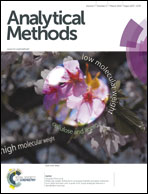A cloud point extraction procedure for gallium, indium and thallium determination in liquid crystal display and sediment samples
Abstract
A simple, sensitive and rapid cloud point extraction (CPE) methodology has been developed for the selective separation and preconcentration of gallium, indium and thallium, after complexation with gallic acid in the presence of Triton X-114 as a non-ionic surfactant. The quantitative extraction of gallium, indium and thallium was performed at pH 2.5, with 0.04 mmol L−1 gallic acid, and 0.05% (w/v) Triton X-114 at 40 °C. The dilution of the surfactant-rich phase with acidified methanol was performed after phase separation, and the metal ions were determined using flame atomic absorption spectrometry. Under the optimized experimental conditions, the calibration curve is linear over the concentration range of 6–150 ng mL−1 for gallium, 2–150 ng mL−1 for indium, and 2–100 ng mL−1 for thallium. The limits of detection, based on three times the standard deviation of a blank signal by seven replicate measurements were 3.50, 1.25 and 0.92 ng mL−1. The relative standard deviations of this method were 1.55, 1.40 and 1.82% for gallium, indium and thallium, respectively (C = 50 ng mL−1, n = 7). The results showed that the developed method was not susceptible to interference effects, providing good recoveries. The developed method was successfully applied to gallium, indium and thallium determination in sediments and mobile phone liquid crystal display samples with satisfactory results.


 Please wait while we load your content...
Please wait while we load your content...